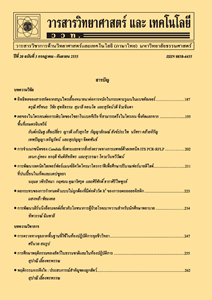A A New Derivatization-Free Hydrophilic Interaction Liquid Chromatography (HILIC) Method for the Quantification of Phenylalanine and Tyrosine
Main Article Content
Abstract
In this research, a new method for determination of phenylalanine and tyrosine without derivatization based on hydrophilic interaction liquid chromatography (HILIC) was proposed. The HILIC separation was performed using guard column (3 mm x 10 mm x 3 µm) and analytical column (3 mm x 150 mm x 3 µm) with dihydroxypropyl groups bonded to silica gel as the stationary phase. The mobile phase consists of acetonitrile : 50 mM ammonium formate pH 3 at 84:16 (v/v) with a flow rate of 0.8 mL/min. Phenylalanine and a-methyl phenylalanine (internal standard) were detected at 210 nm and tyrosine was detected at 225 nm. The internal calibration curves were linear in the range of 1-500 mg/L (r2 = 0.9999). Limits of detection of phenylalanine and tyrosine were 0.7 and 0.3 mg/L, respectively. Limits of quantification of phenylalanine and tyrosine were 1 and 0.8 mg/L, respectively. Phenylalanine and tyrosine contents in eight samples of dietary supplements were analyzed using the developed method and found in the range of 149-577 and 396-499 mg/capsule with the recoveries of 95-102 and 97-102 %, respectively. The advantages of the developed method are simple, fast simultaneous analysis (within 4.5 min), and suitable for quality control in pharmaceutical and dietary supplements industry.
Article Details
References
Foods Highest in Phenylalanine, Available Source: https://nutritiondata.self.com/foods-000086000000000000000-1.html, August 1, 2019.
Showing Metabocard for L-Phenylalanine (HMDB0000159), Available Source: http://www.hmdb.ca/metabolites/HMDB0000159, May 12, 2018.
Glushakov, A.V., Dennis, D.M., Sumners, C., Seubert, C.N. and Martynyuk, A.E., 2003, L-phenylalanine selectively depresses currents at glutamatergic excitatory synapses, J. Neurosci. Res. 72: 116-124.
Wendisch, V.F., 2007, Amino Acid Biosynthesis – Pathways, Regulation and Metabolic Engineering, Springer, Berlin, Heidelberg, 413 p.
Arn, P.H., 2014, Encyclopedia of the Neurological Sciences, Volume 3, 2nd Ed., Academic Press, Oxford, 887 p.
Allard, P., Cowell, L.D., Zytkovicz, T.H., Korson, M.S. and Ampola, M.G., 2004, Determination of phenylalanine and tyrosine in dried blood specimens by ion-exchange chromatography using the Hitachi L-8800 analyzer, Clin. Biochem. 37: 857-862.
Boucher, J.L., Charret, C., Coudray-Lucas, C., Giboudeau, J. and Cynober, L., 1997, Amino acid determination in biological fluids by automated ion-exchange chromatography: Performance of Hitachi L-8500A, Clin. Chem. 43: 1421-1428.
Dale, Y., Mackey, V., Mushi, R., Nyanda, A., Maleque, M. and Ike, J., 2003, Simulta neous measurement of phenylalanine and tyrosine in phenylketonuric plasma and dried blood by high-performance liquid chromatography, J. Chromatogr. B 788: 1-8.
Palego, L., Giannaccini, G. and Lucacchini, A., 2012, RP-LC of Phenylthiocarbamyl Amino Acid Adducts in Plasma Acetonitrile Extracts: Use of Multiple Internal Standards and Variable Wavelength UV Detection, pp. 201-217, In Alterman, M.A. and Hunziker, P. (Eds.), Amino Acid Analysis: Methods and Protocols, Methods in Molecular Biology, Humana Press, Totowa, New Jersey.
Narayan, S.B., Ditewig-Meyers, G., Graham, K.S., Scott, R. and Bennett M.J., 2011, Clin.
Chem. Lab Med. 49: 1177-1185.
Schwarz, E.L., Roberts, W.L. and Pasquali, M., 2005, Analysis of plasma amino acids by HPLC with photodiode array and fluorescence detection, Clin. Chim. Acta 354: 83-90.
Namera, A., Yashiki, M., Nishida, M. and Kojima, T., 2002, Direct extract derivatiza tion for determination of amino acids in human urine by gas chromatography and mass spectrometry, J. Chromatogr. B 776: 49-55.
Deng, C., Deng, Y., Wang, B. and Yang, X., 2002, Gas chromatography-mass spectro metry method for determination of phenylalanine and tyrosine in neonatal blood spots, J. Chromatogr. B 780: 407-413.
Xiong, X., Sheng, X., Liu, D., Zeng, T., Peng, Y. and Wang, Y., 2015, A GC/MS-based metabolomic approach for reliable diagnosis of phenylketonuria, Anal. Bioanal. Chem. 407: 8825-8833.
Buszewski, B. and Noga, S., 2012, Hydrophilic interaction liquid chromato graphy (HILIC) – a powerful separation technique, Anal. Bioanal. Chem. 402: 231-247.
Heaton, J. and Smith, N., 2012, Advan tages and disadvantages of HILIC: A brief overview, Chromatogr. Today. 5: 44-47.
The Association of Analytical Communities, 2012, Appendix K: Guidelines for Dietary Supplements and Botanicals, Part I: AOAC Guidelines for Single-Laboratory Validation of Chemical Methods for Dietary Supplements and Botanicals, AOAC International, 1-15 p.


